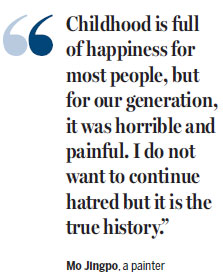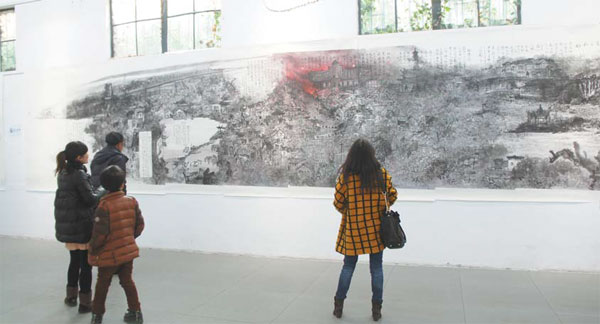Artist records horrors of war
A five-panel artwork by Mo Jingpo was displayed at the Military Museum of the Chinese People's Revolution from April 24 to 26, Zhuan Ti reports.
A 70-meter artwork named Blood Scars in Heaven was displayed at Beijing's Military Museum of the Chinese People's Revolution from April 24 to 26 to commemorate the 70th anniversary of victory in the War of Resistance against Japanese Aggression.
The piece consists of five panels that demonstrate what happened in China during that war. The painting is by famous artist Mo Jingpo, who was forced to leave his hometown of Suzhou at the age of 3 with his mother and brother during the war.
|
Visitors view paintings by Mo Jingpo at an exhibition in Changzhou, Jiangsu province. Provided to China Daily |
"My mother put my brother and me in baskets and escaped our hometown. Japanese aircrafts chased us and dropped bombs around us which caused massive death at that time," said Mo, when recalling the history.
Ma Hongzeng, a renowned art commentator in China, said: "Mo reviewed that shameful history and created the artwork from the angle of an artist and a war survivor. That is why he could make this epic an impressive art piece that other artists are unlikely to be able to make."
Viewing the 70-meter long and 2-meter high artwork can be a sad and shocking experience, as it was for Mo to create. The process took him eight years.
"People have to admit that the history is true at first and then face today's life," Mo said.

Mo's grandfather was hanged by the Japanese for being outside the city after curfew during the war and that tragedy became a part of the painting.
"It is really sad to recall that war history, but if I do not create this painting, will the history be forgotten after hundreds of thousands of years?" Mo asked.
"Suzhou is known as heaven in China's history, but the Japanese made the city hell," he said. "That is why the painting was called Blood Scars in Heaven."
Sha Lili, Mo's wife, said: "He started to draw Japanese soldiers and ordinary Chinese people on small pieces of paper eight years ago. I asked him why he drew this. He said he wanted to show people what the Japanese did in China."
"I want more people, especially the Japanese, to know this shameful history," Mo said.
When planning and researching the painting, Mo frequently traveled to Suzhou to verify the history and sources. He said he would regret not presenting the history clearly in his artwork.
Born in 1938, Mo started to create this artwork in his 70s and completed the work when he was 80-years-old. As the work is very large, he had to move up and down on a ladder. To ensure he remains in good health he often exercises by riding racing bicycles.
"Childhood is full of happiness for most people, but for our generation, it was horrible and painful. I do not want to continue hatred but it is the true history," said Mo.
|
Blood Scars in Heaven I: Invasion of the City 192 cm 1,344 cm. Provided to China Daily |
|
Blood Scars in Heaven II: Fleeing Heaven 192 cm 1,344 cm. Provided to China Daily |
|
Blood Scars in Heaven III: Heaven Immersed in Blood 192 cm 1,344 cm. Provided to China Daily |
|
Blood Scars in Heaven IV: Heaven Turning into Hell 192 cm 1,344 cm. Provided to China Daily |
|
Blood Scars in Heaven V: Dawn Breaks 192 cm 1,344 cm. Provided to China Daily |
(China Daily 04/30/2015 page10)














